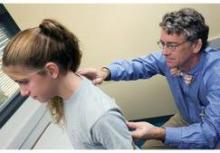WASHINGTON – For patients who come to the office complaining of knee pain, Dr. William Phillips advises physicians to always check for the motion of the hips, a common source of knee pain in athletes with overuse injuries.
At a practical pediatrics meeting sponsored by the American Academy of Pediatrics, Dr. Phillips, chief of the orthopedic service and orthopedic surgery clinic at Texas Children’s Hospital, Houston, recommended the following test to check for hip rotation: While the child is lying supine, flex their hips up to 90 degrees and flex their knees up "and try to internally rotate their legs, which means take their feet out and point the kneecaps in." X-rays are not necessary in these cases, he added.
Dr. Phillips also emphasized the value of encouraging patients with knee pain to start doing isometric exercises, which can be taught in the office and can be done at home. With a few exceptions, "the cure-all exercise for virtually every type of knee pain ... is isometric quadriceps strengthening exercises."
Repetitive overuse injuries occur when "an excessive, repetitive load overwhelms the body’s normal repair processes." Such injuries account for the majority of sports injuries seen by pediatricians – a result of the trend toward earlier specialization in sports, more-intensive involvement starting at younger ages, and year-round participation in one sport. These injuries can be soft-tissue or bony injuries, said Dr. Phillips, professor of pediatrics at Baylor College of Medicine, Houston.
In any evaluation, the history is the most important element, he said. The physical exam can be helpful, but imaging studies are less useful. He recommended asking patients when they experience pain, such as during an athletic activity; whether it limits their performance; what they are able to do; and how long they have been experiencing the pain.
Another question is whether there have been recent changes in their activity or sports practices, said Dr. Phillips. He described three cheerleaders from the same squad who came to his office complaining of the same type of knee pain around the same time. The cause turned out to be a new drill they were doing in practice.
An x-ray may be considered in situations that include a history of acute swelling, obvious limb asymmetry, limited range of motion, and certainly, when the patient is unable to bear weight. An x-ray "is usually not needed when the condition is bilateral ... and clearly the same on both sides," he said. But he added that he always offers the family the option of getting an x-ray if the child has not improved after a certain amount of time.
Injuries to the extensor mechanisms are probably the most common overuse injuries. "And again, knee pain can be referred from the hip," Dr. Phillips pointed out. Every year, he sees junior high school football players who have twisted their knees in a game and have been limping, but have a normal knee exam and turn out to have a slipped lateral femoral epiphysis. "So be sure to check the hips," he said, noting that the range of motion should be symmetrical, with at least 20 or 30 degrees of internal rotation, "and the feet go out, the kneecaps go in."
The most common causes of knee pain in young athletes are extensor patellofemoral problems, characterized by pain with such activities as running or climbing stairs. Another activity that elicits this type of pain is rising up from a sitting position, which "jams" the patellofemoral joint, he said. In such cases, there tends to be tenderness under the patella. "Usually, if you push the patella a little bit laterally, they will have pain."
Management of patellofemoral problems includes activity as tolerated; ice and analgesics; isometric quadriceps strengthening; and quadriceps and hamstring stretching. A brace – the type with a neoprene sleeve with a hole cut out, not a metal brace – is also acceptable to use if the patient likes it, but it is not essential, Dr. Phillips said.
Physical therapy is not usually necessary. Instead, he recommends teaching children who present with knee pain the following fundamental exercise: While lying down, bend the unaffected leg and keep that foot flat on the floor, then lift the affected leg 6-12 inches off the table with the knee fully extended, toe pointed to the ceiling – keeping it up for 20 seconds, down for 10 seconds, and repeating this for one or two sets of 20 repetitions, depending on the child and other factors. They should avoid lifting both legs up off the ground at the same time, which can hurt their backs.


